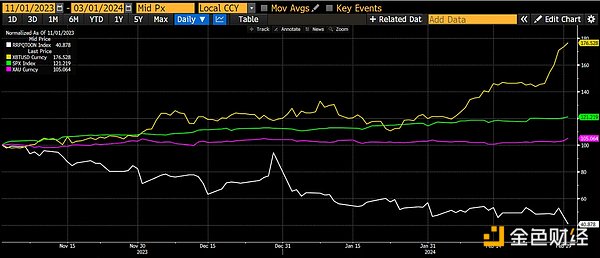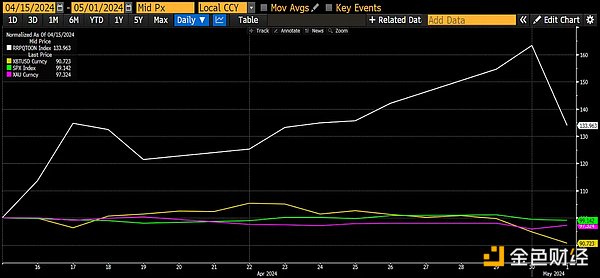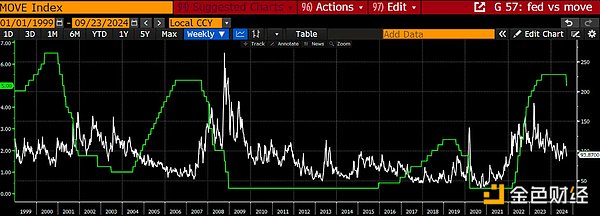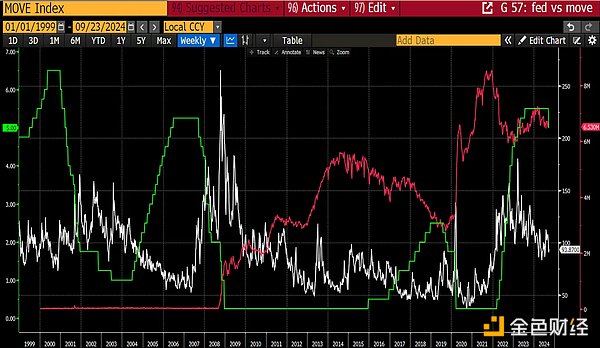Author: Arthur Hayes; Translated by: Plain Blockchain
(Any opinions expressed in this article are the author’s personal opinions and should not be used as the basis for investment decisions, nor should they be considered as recommendations or suggestions for investment transactions.)
It was a crazy week. If you are a newbie who didn’t fly to Singapore last week for Token2049, I can only pray for your soul. Over 20,000 faithful worshippers praised God in whatever way they saw fit. I attend the Singapore F1 night race almost every year, but I have never seen the city so alive.
Attendance at Token2049 doubles every year, and I’ve heard of obscure projects paying up to $650,000 just to get a chance to speak on stage — and that’s just on those small stages.
It was packed. Marquee is a club that can hold thousands of people. Look at the line that was over three hours long, everyone wanted to get in and participate in this event. Every night of the week, a different crypto project or company has reserved the venue. The rental fee for Marquee (not including alcohol) is as high as $200,000.

There are all kinds of activities to suit all kinds of people. Iggy Azalea brought in a bunch of strippers from LA to create a pop-up "experience". Who would have thought strippers would know how to survive a volatile market? ;)
Even this clown Su Zhu (Randall of crypto) can't help wanting to "rain". Randall, why do you look so uncomfortable in this video? Losing money is a must. When you finally hand over your assets to the BVI bankruptcy court and resolve the lawsuit, I will be happy to have you at Magic City and teach you how to play.

I'm thinking of asking Branson Cognac and Le Chemin du Roi to sponsor my next party... like 50 Cent said:

Every hotel was full, as were the regular restaurants. When the data is tallied in 2024, I suspect we’ll find that the crypto scene generated more business for airlines, hotels, restaurants, conference venues, and nightclubs than any other activity in Singapore’s history.
Fortunately, Singapore tries to remain geopolitically neutral, which means that as long as you believe in Satoshi Nakamoto, you can basically come here to celebrate with like-minded brothers and sisters.
The energy of the crypto community is in stark contrast to the dullness of traditional finance conference attendees. The Milken Institute also held a conference the same week. If you walk around the Four Seasons Hotel, every man and woman there looks the same, wearing drab business casual or formal clothing. This traditional finance attire and behavior is obviously intentional. They want the public to think "nothing to see", while in the meantime, they steal human dignity with inflation. Volatility is their enemy, because once things start to move, ordinary people can look through this mirror and witness the true depravity of their masters.
Today, we’re going to talk about volatility in cryptocurrencies and the volatility that’s missing from traditional finance. I want to talk about how the elites print money to create the appearance of a calm economy. I also want to explore how Bitcoin is a fiat release valve that suppresses volatility to unnatural levels. But first, I want to make a remarkable point by reviewing the record from November 2023 to date: short-term macroeconomic forecasts don’t matter.
1. My prediction accuracy
Many readers and crypto keyboard warriors often criticize me for doing something wrong. So, how did I perform on my key judgments over the past year?
November 2023:
I wrote an article called "Bad Girls". In this article, I predicted that US Treasury Secretary "Bad Girl" Yellen would issue more T-bills to drain funds from the US Federal Reserve's reverse repurchase program (RRP). The decline in RRP will inject liquidity into the market, driving risk assets higher. I think the market will soften somewhat by March 2024 when the Bank Term Funding Program (BTFP) expires.

From November 2023 to March 2024, the Reverse Repurchase Program (RRP, white) fell 59%, Bitcoin (gold) rose 77%, the S&P 500 (green) rose 21%, and gold (magenta) rose 5%. Each set of data is based on 100.
I win this one.
After reading the US Treasury’s Quarterly Refinancing Announcement (QRA), I added more crypto exposure. In retrospect, this was a very good decision.
March 2024:
In my article, “Yellen or Bullshit?”, I speculated that the Bank Term Funding Program (BTFP) would not be renewed because of its clear inflationary characteristics. I argued that simply giving banks access to the discount window would not be enough to avoid another US banking crisis that was not “too big to fail.”
The expiration of BTFP did not have any substantial impact on the market.
I lose on this one.
I lost money on my small position in Bitcoin put options.
April 2024:
In my article “The Heat Wave”, I predicted that US tax season would cause crypto prices to fall as USD liquidity was withdrawn from the market. Specifically, I said there would be a pause in adding any additional crypto exposure between April 15th and May 1st.

From April 15 to May 1, the Reverse Repurchase Program (RRP, white) rose 33%, Bitcoin (gold) fell 9%, the S&P 500 (green) fell 1%, and gold (magenta) fell 3%. Each data set is based on 100.
I win this one.
May 2024:
As I prepare to leave for my summer vacation in the northern hemisphere, I publish a call for help based on a number of macroeconomic factors. My predictions are as follows:
Did Bitcoin hit a low of around $58,600 earlier this week? Yes.
What is your price prediction? A rally above $60,000 and then range between $60,000 and $70,000 until August.
Bitcoin’s low on August 5 was around $54,000 as the USD-JPY carry trade unwound. I was off by 8%.
I lose on this one.
During this period, Bitcoin has been range-bound between roughly $54,000 and $71,000.
I lose on this one too.
I did add some exposure to “shit coin” during the summer doldrums. Some of the coins I bought are now trading below what I bought them for, and some are above.
June and July 2024:
When Japan's fifth-largest bank admitted its huge losses on foreign currency bonds, I wrote an article on the importance of the dollar-yen exchange rate titled "Nothing Can Be Done". I predicted that the Bank of Japan would not raise interest rates because it would endanger the banking system. This proved to be a naive assumption. On July 31, the Bank of Japan raised interest rates by 0.15%, triggering a violent unwinding of the dollar-yen carry trade. I followed up on the mechanics of the dollar-yen carry trade unwinding in a follow-up article "Spirited Away".
While USD-JPY proved to be the most important macroeconomic variable, I was wrong about the Bank of Japan. The policy response was not what I had predicted. Rather than providing dollars through central bank swap arrangements as I had expected, the Bank of Japan assured the market that they would not raise rates or adjust monetary policy if that would lead to increased market volatility.
I lose on this one too.

August 2024:
Two major events occurred this month: the U.S. Treasury’s release of the Quarterly Refinancing Announcement (QRA) for the third quarter of 2024, and Powell’s “Wage Turning Point” speech at Jackson Hole.
I predicted that the "bad girl" Yellen's re-issuance of T-bills would provide dollar liquidity to the market. However, after Powell's turnaround speech, he confirmed that he would cut interest rates in September, and these two forces offset each other. At first, I thought that the net issuance of T-bills would increase liquidity because it would drain the reverse repurchase program (RRP) to zero, but then the Treasury yield fell below the RRP level, and I predicted that the reverse repurchase program would increase and drain liquidity.
I didn't expect Powell to cut rates before the election and risk an outbreak of inflation when voters go to the polls.
I lose on this one.
The balance of the reverse repo program increased directly after Jackson Hole and is back on an upward trajectory. Therefore, I still believe that this will act as a slight liquidity drag as Treasury yields continue to fall and the market expects the Fed to cut rates further at its November meeting.
The results are yet to be determined; it is too early to tell if I am right.
September 2024:
When I left the mountains of Patagonia, I wrote an article, “Boom Time… Delayed,” and gave talks at Korea Blockchain Week and the Token2049 conference in Singapore, predicting that the market would react negatively if the Fed cut rates. Specifically, I argued that a narrowing of the USD-JPY spread would lead to further yen strength and reignite carry trade unwinding. This would cause a decline in global markets, including cryptocurrencies, and ultimately require more money printing to repair the market.
The Fed cut rates while the Bank of Japan kept rates unchanged, narrowing the interest rate differential. However, the yen weakened against the dollar and risk markets performed well.
I lose on this one too.
result:
Correct predictions: 2
Wrong predictions: 6
So batting average = .250. That's pretty bad for the average person, but as the great Hank Aaron said, "My motto has always been to keep swinging. Whether I'm down, feeling sick, or having a hard time off the field, the only thing to do is keep swinging." Aaron's lifetime batting average was .305, and he is considered one of the greatest baseball players of all time.
2. Even though I encountered many unexpected risks, I still made money.
1) Why? Huge Assumption
The exercise I perform when writing these macroeconomic articles is really an attempt to predict the specific events that will lead to policy responses from those of us who are corrupt and in power. We know that due to overleveraging after the Bretton Woods system in 1971, any volatility in the financial markets is something they cannot afford. We (meaning the puppets of traditional finance and the followers of Satoshi) all agree that when things get out of control, the “Brrrr” button will be pressed. This is always their policy response.
If I can predict the triggers that will cause volatility in advance, then my confidence will be boosted, and maybe I can earn a few more percentage points by acting slightly ahead of time. However, as long as my portfolio benefits from the fiat currency being printed to dampen the natural volatility of human civilization, then it doesn't matter if I'm wrong on every event-driven forecast, as long as the policy response is in line with expectations.
I’ll show you two charts to help you understand the massive amounts of fiat needed to suppress volatility at historically low levels.
2) Volatility
Starting in the late 19th century, the elites who controlled global government struck a deal with ordinary people. If ordinary people surrendered more and more freedoms, then the "wise" ones would create a calm universe by controlling chaos, disorder, and volatility. As the decades progressed, and the role of government in every citizen's life grew, it became extremely expensive to maintain the semblance of continued order in an increasingly complex world.
Prior to this, a handful of people wrote the definitive books on the workings of the universe. They killed or ostracized anyone who did scientific research. But when we freed ourselves from the shackles of organized religion and thought critically about the universe we inhabit, we realized that our knowledge of things was insignificant and that things were much more complicated than you could understand by reading the Bible, Torah, or Quran, etc. So people tended to follow politicians (mostly men, a few women), who replaced the priests, rabbis, and imams (always men, never women), offering advice on a way to live, promising security, and giving a framework for understanding the workings of the universe. But every time volatility rises, the response is to print more money and cover up the various problems facing the world to avoid admitting that no one knows what the future will bring.
Just like if you push an inflatable ball down under water, the deeper you push it, the more energy it takes to keep it in place. The distortions are so severe globally, especially for the American Empire, that the amount of money printed each year to maintain the status quo is growing exponentially. That’s why I can confidently say that the amount of fiat money printed between now and the final system reset will far exceed the total amount printed from 1971 to date. It’s just math and physics.
The first chart I will show you is the MOVE Index (white), which measures US bond market volatility relative to the Fed Funds Cap Rate (green). As you know, I believe volume is more important than price, but in this case, using price to present the picture is extremely clear.

Some of you may remember the tech bubble boom and bust in 2000. As you can see, the Fed deflated the bubble by raising interest rates until something broke. Volatility in the bond market spiked in 2000 and 2001 after the 9/11 attacks. Each time volatility rose, the Fed cut interest rates. After volatility fell, the Fed felt it could return to normal interest rates, but then the subprime housing market crisis broke out, which led to the 2008 Global Financial Crisis (GFC). Interest rates were quickly cut to zero and remained there for nearly seven years to suppress volatility. When it was time to return to normal interest rates again, the COVID pandemic hit, causing a bond market crash and a surge in volatility. In response, the Fed cut interest rates to zero again. Inflation fueled by the pandemic ignited the bond market starting in 2021, further increasing volatility. The Fed raised interest rates to control inflation, but had to stop during the non-TBTF banking crisis in March 2023. Finally, the current Fed easing cycle began amidst increased bond market volatility. If the period from 2008 to 2020 is considered “normal,” then current bond market volatility is almost twice the level that those in power are comfortable with.
Let's add one more proxy for the dollar amount. The red line is an approximation of total bank credit, which combines excess bank reserves held at the Fed with other deposits and liabilities (ODL), which is a good proxy for commercial bank loan growth. Remember from Econ 101 that the banking system creates money by extending credit. As the Fed engages in quantitative easing, excess reserves increase, and as banks extend more loans, other deposits and liabilities also increase.

As you can see, 2008 was a watershed moment. The magnitude of the financial crisis caused a surge in credit-based money that overshadowed what happened after the tech bubble crash of 2000. No wonder our lord Satoshi created Bitcoin in 2009. Since then, the total amount of bank credit has never fully diminished. This fiat credit cannot be eliminated or the system would collapse under its own weight. Furthermore, in every crisis, banks must create more and more credit to suppress volatility.
I could present a similar chart showing the relationship between FX volatility in USD/CNY, USD/JPY, EUR/JPY, etc. and government debt levels, central bank balance sheets, and bank credit growth. While these charts are not as clear as the ones I just presented, they still convey important information. For US hegemony, bond market volatility is critical because it is the asset that backs the global reserve currency, the dollar. Every other ally, client, and enemy nation watches the volatility of their currencies against the dollar because it affects their ability to trade with the world.
3) Reaction
All of this fiat money has to go somewhere. Bitcoin and cryptocurrencies are the release valve, and the fiat money needed to keep volatility low will flow into the crypto markets. Assuming the Bitcoin blockchain is technically sound, Bitcoin will benefit from the elites constantly trying to break the laws of physics. There has to be a balancer; you can’t get something out of thin air. For every action, there is a reaction. Bitcoin happens to be the most technically sound way to balance the wasteful behavior of the ruling elite in this modern digital world.
As an investor, trader, and speculator, your goal is to acquire Bitcoin at the lowest possible cost. This could mean pricing your labor in Bitcoin, mining Bitcoin using cheap excess energy, borrowing fiat at low rates and buying Bitcoin (note Michael Saylor), or buying Bitcoin with some fiat savings. The volatility between Bitcoin and fiat is your asset, don’t waste that opportunity by using leverage to buy Bitcoin that you intend to hold for the long term.
4) Risks
Profitable speculation from short-term price fluctuations is difficult. As you can see, my record is 2 wins and 6 losses. If I had gone all-in on long and short positions every time I made a call, Maelstrom would probably be bankrupt by now. Randall and Kyle Davis are right; the elites are in a super cycle of volatility suppression. They have no patience and instead borrow in fiat to buy more Bitcoin, and as the cost of funding in fiat changes (which it always does), they end up getting caught and losing everything. Well, not everything - I've seen pictures of Randall throwing lavish parties in his Singapore mansion. Don't worry though, the house was purchased in the names of his children to avoid being seized by the bankruptcy court.
Assuming you haven’t abused fiat leverage, the real risk is that the elites can no longer suppress volatility and it will surge back to its natural level. At that point, the system will reset. Will it be like the Bolshevik Revolution in Russia, where asset holders are wiped out, or will it be like the more common scenario, where one set of corrupt elites is replaced by another and the suffering of the masses continues under a new “ism”? In any case, everything will fall, and Bitcoin will fall less relative to the ultimate asset, energy. Even though your overall wealth is reduced, you are still beating the market. Sorry, nothing in the universe is risk-free. Security is an illusion, marketed by scammers eager for your vote on election day.
3. Trading strategy
1) United States
Based on the Fed's historical response to "high volatility", we know that once they start cutting rates, they usually don't stop until rates are close to 0%. In addition, we know that bank credit growth must accelerate as rates are cut. I don't care how "strong" the economy is, how low unemployment is, or how high inflation is, the Fed will continue to cut rates and the banking system will release more dollars. The government will also continue to borrow as much as it can to keep the public's support no matter who wins the US presidential election.
2) European Union
The EU’s unelected bureaucrats are suicidal in destroying their economies by rejecting cheap and abundant Russian energy and by dismantling their energy production capacity in the name of “climate change,” “global warming,” “environmental, social and governance” (ESG) or other fancy slogans. The economic downturn will be met with lower euro interest rates set by the European Central Bank. Governments will also start forcing banks to lend more to local companies to create jobs and rebuild crumbling infrastructure.
3) China
As the Fed cuts rates and U.S. banks issue more credit, the dollar will weaken. This allows the Chinese government to increase credit growth while maintaining a stable dollar-yuan exchange rate. Chinese President Xi Jinping's main concern about accelerating bank credit growth is the pressure on the yuan to depreciate relative to the dollar. If the Fed prints money, the People's Bank of China (PBOC) can also print money. This week, the PBOC launched a series of interest rate cuts across China's monetary system. This is just the beginning; the real "blockbuster" will come when Xi instructs banks to issue more credit.
4) Japan
If other major economies are easing monetary policy now, there is less pressure on the Bank of Japan (BOJ) to raise interest rates quickly. BOJ Governor Kazuo Ueda has made it clear that he will normalize interest rates. But since interest rates in other economies have fallen to low levels, he does not need to rush to follow suit.
4. Conclusion
The moral of the story is that the global elite are once again suppressing volatility in their countries or economic zones by lowering the price of money and increasing the quantity of money. If you are fully invested in crypto, sit back, relax, and watch the fiat value of your portfolio rise. If you still have extra fiat, use this opportunity and put it into the crypto market. For Maelstrom, we will push projects that have delayed coin launches due to poor markets to launch as soon as possible. We hope to see those green candles in our Christmas stockings. In the meantime, the partners of the fund are also looking forward to receiving generous bonuses in 2024, so please support them!







